Geopolymer Concrete Physical and Mechanical Properties on a Combined Binder Reinforced with Dispersed Polypropylene Fiber
Abstract
1. Introduction
- −
- Development of experimental compositions of geopolymer concrete on a combined binder with different ratios of GGBS and FA and selection of the optimal dosage of polypropylene fiber;
- −
- Production of fresh geopolymer concrete on a combined binder and control of its density and slump;
- −
- Production of geopolymer concrete samples and evaluation of its density and compressive and flexural strength. Analysis of the structure of geopolymer composite reinforced with polypropylene fiber;
- −
- Analysis of the experimental results and selection of the most optimal formulation of geopolymer fiber-reinforced concrete, allowing us to obtain a composite with the required performance properties;
- −
- Development of recommendations for the practical use of the obtained geopolymer concrete reinforced with dispersed polypropylene fiber.
2. Materials and Methods
2.1. Materials
2.2. Methods
3. Results and Discussion
3.1. The Performance of Geopolymer Concrete Evaluation on a Combined Binder
3.2. Assessment of Geopolymer Concrete Performance on a Combined Binder Reinforced with Polypropylene Fiber
- -
- Qualitative and quantitative characteristics of the feedstock for its further use in geopolymer concrete technology were determined;
- -
- The most rational compositions of the geopolymer binder system for obtaining highly effective geopolymer concretes were obtained;
- -
- The optimal composition of the geopolymer binder was selected by combining 80% GGBS and 20% FA with a compressive strength of 31.5 MPa;
- -
- The optimal PF content of up to 0.6–1.0% was selected for dispersed reinforcement of geopolymer concrete.
4. Conclusions
Author Contributions
Funding
Institutional Review Board Statement
Data Availability Statement
Acknowledgments
Conflicts of Interest
References
- Gaidzhurov, P.P.; Volodin, V.A. Strength Calculation of the Coupling of the Floor Slab and the Monolithic Reinforced Concrete Frame Column by the Finite Element Method. Adv. Eng. Res. 2022, 22, 306–314. [Google Scholar] [CrossRef]
- Araújo, L.B.R.; Targino, D.L.L.; Babadopulos, L.F.A.L.; Fabbri, A.; Cabral, A.E.B.; Chehade, R.; Costa, H.N. Impact of Curing Temperature and Steel Slag Aggregates on High-Strength Self-Compacting Alkali-Activated Concrete. Buildings 2025, 15, 457. [Google Scholar] [CrossRef]
- Nikmehr, B.; Al-Ameri, R. A State-of-the-Art Review on the Incorporation of Recycled Concrete Aggregates in Geopolymer Concrete. Recycling 2022, 7, 51. [Google Scholar] [CrossRef]
- Ahmed, H.U.; Mohammed, A.A.; Rafiq, S.; Mohammed, A.S.; Mosavi, A.; Sor, N.H.; Qaidi, S.M.A. Compressive Strength of Sustainable Geopolymer Concrete Composites: A State-of-the-Art Review. Sustainability 2021, 13, 13502. [Google Scholar] [CrossRef]
- Shcherban’, E.M.; Stel’makh, S.A.; Beskopylny, A.; Mailyan, L.R.; Meskhi, B. Increasing the Corrosion Resistance and Durability of Geopolymer Concrete Structures of Agricultural Buildings Operating in Specific Conditions of Aggressive Environments of Livestock Buildings. Appl. Sci. 2022, 12, 1655. [Google Scholar] [CrossRef]
- Gulam, N.F.B.A.; Kaish, A.B.M.A.; Mahmood, A.; Raman, S.N.; Jamil, M.; Hamid, R. A Review on the Effect of Fly Ash, RHA and Slag on the Synthesizing of Coal Bottom Ash (CBA) Based Geopolymer. Eng. Proc. 2021, 11, 20. [Google Scholar] [CrossRef]
- Luhar, S.; Luhar, I.; Shaikh, F.U.A. Review on Performance Evaluation of Autonomous Healing of Geopolymer Composites. Infrastructures 2021, 6, 94. [Google Scholar] [CrossRef]
- Ionescu, B.A.; Lăzărescu, A.-V.; Hegyi, A. The Possibility of Using Slag for the Production of Geopolymer Materials and Its Influence on Mechanical Performances—A Review. Proceedings 2020, 63, 30. [Google Scholar] [CrossRef]
- Cheng, J.; Qin, Y.; Yao, Z.; Luo, L.; Qu, C. Study on the Chloride–Sulfate Resistance of a Metakaolin-Based Geopolymer Mortar. Materials 2024, 17, 5045. [Google Scholar] [CrossRef]
- Murtazaev, S.-A.Y.; Salamanova, M.S.; Saidumov, M.S.; Gatsaev, Z.S.; Alaskhanov, A.K.; Murtazaeva, T.S.-A. Development of geopolymer binders. Constr. Mater. Prod. 2024, 7, 4. [Google Scholar] [CrossRef]
- Adeleke, B.O.; Kinuthia, J.M.; Oti, J.; Ebailila, M. Physico-Mechanical Evaluation of Geopolymer Concrete Activated by Sodium Hydroxide and Silica Fume-Synthesised Sodium Silicate Solution. Materials 2023, 16, 2400. [Google Scholar] [CrossRef] [PubMed]
- He, W.; Li, B.; Meng, X.; Shen, Q. Compound Effects of Sodium Chloride and Gypsum on the Compressive Strength and Sulfate Resistance of Slag-Based Geopolymer Concrete. Buildings 2023, 13, 675. [Google Scholar] [CrossRef]
- Arunachelam, N.; Maheswaran, J.; Chellapandian, M.; Murali, G.; Vatin, N.I. Development of High-Strength Geopolymer Concrete Incorporating High-Volume Copper Slag and Micro Silica. Sustainability 2022, 14, 7601. [Google Scholar] [CrossRef]
- Hema, P.; Revathi, V. Durability Evaluation of GGBS-RHA-Based Geopolymer Concrete Along with Lightweight Expanded Clay Aggregate Using SEM Images and EDAX Analysis. Buildings 2024, 14, 3355. [Google Scholar] [CrossRef]
- Oti, J.; Adeleke, B.O.; Mudiyanselage, P.R.; Kinuthia, J. A Comprehensive Performance Evaluation of GGBS-Based Geopolymer Concrete Activated by a Rice Husk Ash-Synthesised Sodium Silicate Solution and Sodium Hydroxide. Recycling 2024, 9, 23. [Google Scholar] [CrossRef]
- Liu, S.; Liu, Z.; Takasu, K.; Koyamada, H.; Suyama, H. Study on the Effect of Recycled Fine Aggregate Qualities on Fly Ash/GGBS-Based Geopolymer Mortar. Materials 2023, 16, 7289. [Google Scholar] [CrossRef]
- Polydorou, T.; Spanou, M.; Savva, P.; Sakkas, K.; Oikonomopoulou, K.; Petrou, M.F.; Nicolaides, D. Development of a High Strength Geopolymer Incorporating Quarry Waste Diabase Mud (DM) and Ground Granulated Blast-Furnace Slag (GGBS). Materials 2022, 15, 5946. [Google Scholar] [CrossRef]
- Thakur, G.; Singh, Y.; Singh, R.; Prakash, C.; Saxena, K.K.; Pramanik, A.; Basak, A.; Subramaniam, S. Development of GGBS-Based Geopolymer Concrete Incorporated with Polypropylene Fibers as Sustainable Materials. Sustainability 2022, 14, 10639. [Google Scholar] [CrossRef]
- Hamed, Y.R.; Keshta, M.M.; Elshikh, M.M.Y.; Elshami, A.A.; Matthana, M.H.S.; Youssf, O. Performance of Sustainable Geopolymer Concrete Made of Different Alkaline Activators. Infrastructures 2025, 10, 41. [Google Scholar] [CrossRef]
- Xu, Q.; Shang, N.; Ko, J.H. Utilization of Municipal Solid Waste Incineration (MSWIFA) in Geopolymer Concrete: A Study on Compressive Strength and Leaching Characteristics. Materials 2024, 17, 4609. [Google Scholar] [CrossRef]
- Marczyk, J.; Ziejewska, C.; Gądek, S.; Korniejenko, K.; Łach, M.; Góra, M.; Kurek, I.; Doğan-Sağlamtimur, N.; Hebda, M.; Szechyńska-Hebda, M. Hybrid Materials Based on Fly Ash, Metakaolin, and Cement for 3D Printing. Materials 2021, 14, 6874. [Google Scholar] [CrossRef] [PubMed]
- Waqas, R.M.; Butt, F. Behavior of Quarry Rock Dust, Fly Ash and Slag Based Geopolymer Concrete Columns Reinforced with Steel Fibers under Eccentric Loading. Appl. Sci. 2021, 11, 6740. [Google Scholar] [CrossRef]
- Le, H.-B.; Bui, Q.-B.; Tang, L. Geopolymer Recycled Aggregate Concrete: From Experiments to Empirical Models. Materials 2021, 14, 1180. [Google Scholar] [CrossRef] [PubMed]
- Zailani, W.W.A.; Abdullah, M.M.A.B.; Arshad, M.F.; Razak, R.A.; Tahir, M.F.M.; Zainol, R.R.M.A.; Nabialek, M.; Sandu, A.V.; Wysłocki, J.J.; Błoch, K. Characterisation at the Bonding Zone between Fly Ash Based Geopolymer Repair Materials (GRM) and Ordinary Portland Cement Concrete (OPCC). Materials 2021, 14, 56. [Google Scholar] [CrossRef] [PubMed]
- Agustini, N.K.A.; Triwiyono, A.; Sulistyo, D.; Suyitno, S. Mechanical Properties and Thermal Conductivity of Fly Ash-Based Geopolymer Foams with Polypropylene Fibers. Appl. Sci. 2021, 11, 4886. [Google Scholar] [CrossRef]
- Nikoloutsopoulos, N.; Sotiropoulou, A.; Kakali, G.; Tsivilis, S. Physical and Mechanical Properties of Fly Ash Based Geopolymer Concrete Compared to Conventional Concrete. Buildings 2021, 11, 178. [Google Scholar] [CrossRef]
- Ahmad Zailani, W.W.; Bouaissi, A.; Abdullah, M.M.A.B.; Abd Razak, R.; Yoriya, S.; Mohd Salleh, M.A.A.; Rozainy M. A. Z., M.R.; Fansuri, H. Bonding Strength Characteristics of FA-Based Geopolymer Paste as a Repair Material When Applied on OPC Substrate. Appl. Sci. 2020, 10, 3321. [Google Scholar] [CrossRef]
- Hussain, K.; Butt, F.; Alwetaishi, M.; Waqas, R.M.; Aslam, F.; Ibraheem, M.; Zhu, X.; Ahmad, N.; Tufail, R.F.; Musarat, M.A.; et al. Effect of Quarry Rock Dust as a Binder on the Properties of Fly Ash and Slag-Based Geopolymer Concrete Exposed to Ambient and Elevated Temperatures. Appl. Sci. 2021, 11, 9192. [Google Scholar] [CrossRef]
- Jiang, C.; Wang, A.; Bao, X.; Chen, Z.; Ni, T.; Wang, Z. Protective Geopolymer Coatings Containing Multi-Componential Precursors: Preparation and Basic Properties Characterization. Materials 2020, 13, 3448. [Google Scholar] [CrossRef]
- Wei, X.; Ming, F.; Li, D.; Chen, L.; Liu, Y. Influence of Water Content on Mechanical Strength and Microstructure of Alkali-Activated Fly Ash/GGBFS Mortars Cured at Cold and Polar Regions. Materials 2020, 13, 138. [Google Scholar] [CrossRef]
- Bhina, M.R.; Liu, K.-Y.; Hu, J.-E.H.-Y.; Tsai, C.-T. Investigation of the Mechanical Properties of Quick-Strength Geopolymer Material Considering Preheated-to-Room Temperature Ratio of Sand, Na2SiO3-to-NaOH Ratio, and Fly Ash-to-GGBS Ratio. Polymers 2023, 15, 1084. [Google Scholar] [CrossRef]
- Ionescu, B.A.; Barbu, A.-M.; Lăzărescu, A.-V.; Rada, S.; Gabor, T.; Florean, C. The Influence of Substitution of Fly Ash with Marble Dust or Blast Furnace Slag on the Properties of the Alkali-Activated Geopolymer Paste. Coatings 2023, 13, 403. [Google Scholar] [CrossRef]
- Xiao, S.; Cai, Y.; Guo, Y.; Lin, J.; Liu, G.; Lan, X.; Song, Y. Experimental Study on Axial Compressive Performance of Polyvinyl Alcohol Fibers Reinforced Fly Ash—Slag Geopolymer Composites. Polymers 2022, 14, 142. [Google Scholar] [CrossRef] [PubMed]
- Meskhi, B.; Beskopylny, A.N.; Stel’makh, S.A.; Shcherban’, E.M.; Mailyan, L.R.; Shilov, A.A.; El’shaeva, D.; Shilova, K.; Karalar, M.; Aksoylu, C.; et al. Analytical Review of Geopolymer Concrete: Retrospective and Current Issues. Materials 2023, 16, 3792. [Google Scholar] [CrossRef]
- Zubarev, K.P.; Shcherban’, E.M.; Stel’makh, S.A.; Beskopylny, A.N.; Elshaeva, D.; Chernil’nik, A.; Zakieva, N.I.; Pimenova, E.V.; Shilov, A.A. Structure and Properties Improvement by Recipe Factors of Geopolymer Basalt Fiber Reinforced Concrete for Building Enclosing Structures. Buildings 2024, 14, 743. [Google Scholar] [CrossRef]
- Saprykina, T.K.; Zhadanov, V.I. Improving Theoretical Concepts of Composition Design of Dispersedly-Reinforced Concretes. Mod. Trends Constr. Urban Territ. Plan. 2024, 3, 66–73. [Google Scholar] [CrossRef]
- Su, J.; Mao, J.; Zhou, B.; Zhang, W.; Wang, L.; Mu, C. Dynamic compressive mechanical properties of fibre-reinforced geopolymer concrete. Case Stud. Constr. Mater. 2025, 22, e04268. [Google Scholar] [CrossRef]
- Nikmehr, B.; Kafle, B.; Al Zand, A.W.; Al-Ameri, R. The effect of hybrid basalt fibres on the mechanical and structural characteristics of geopolymer concrete containing geopolymer-coated recycled concrete aggregates. Constr. Build. Mater. 2024, 450, 138649. [Google Scholar] [CrossRef]
- Zhang, Y.H.; Zhong, W.L.; Fan, L.F. Long-term durability investigation of basalt fiber-reinforced geopolymer concrete in marine environment. J. Mater. Res. Technol. 2024, 31, 593–605. [Google Scholar] [CrossRef]
- Zhang, P.; Feng, Z.; Guo, J.; Zheng, Y.; Yuan, P. Mechanical behavior and microscopic damage mechanism of hybrid fiber-reinforced geopolymer concrete at elevated temperature. Ceram. Int. 2024, 50, 53851–53866. [Google Scholar] [CrossRef]
- Yan, J.; Wang, J.; Chen, H.; Xiang, P. High Temperature Exposure Assessment of Graphene Oxide Reinforced Cement. Front. Mater. 2022, 9, 786260. [Google Scholar] [CrossRef]
- Cao, B.; Li, Y.; Li, P. Synergistic Effect of Blended Precursors and Silica Fume on Strength and High Temperature Resistance of Geopolymer. Materials 2024, 17, 2975. [Google Scholar] [CrossRef]
- Mirgozar Langaroudi, M.A.; Mohtasham Moein, M.; Saradar, A.; Karakouzian, M. Investigation of the Mechanical Properties and Durability of Fiber-Reinforced Geopolymer Mortars Containing Metakaolin and Glass Powder. Infrastructures 2025, 10, 25. [Google Scholar] [CrossRef]
- Al-mashhadani, M.M.; Canpolat, O.; Aygörmez, Y.; Uysal, M.; Erdem, S. Mechanical and microstructural characterization of fiber reinforced fly ash based geopolymer composites. Constr. Build. Mater. 2018, 167, 505–513. [Google Scholar] [CrossRef]
- Masoud, L.; Hammoud, A.; Mortada, Y.; Masad, E. Rheological, mechanical, and microscopic properties of polypropylene fiber reinforced-geopolymer concrete for additive manufacturing. Constr. Build. Mater. 2024, 438, 137069. [Google Scholar] [CrossRef]
- Rani, S.Y.; Nusari, M.S.; bin Non, J.; Poddar, S.; Bhaumik, A. Durability of geopolymer concrete with addition of polypropylene fibre. Mater. Today Proc. 2022, 56, 2846–2851. [Google Scholar] [CrossRef]
- Shcherban’, E.M.; Stel’makh, S.A.; Beskopylny, A.N.; Meskhi, B.; Efremenko, I.; Shilov, A.A.; Vialikov, I.; Ananova, O.; Chernil’nik, A.; Elshaeva, D. Composition, Structure and Properties of Geopolymer Concrete Dispersedly Reinforced with Sisal Fiber. Buildings 2024, 14, 2810. [Google Scholar] [CrossRef]
- Raza, A.; Ahmed, B.; Hechmi El Ouni, M.; Chen, W. Mechanical, durability and microstructural characterization of cost-effective polyethylene fiber-reinforced geopolymer concrete. Constr. Build. Mater. 2024, 432, 136661. [Google Scholar] [CrossRef]
- Mansourghanaei, M.; Biklaryan, M.; Mardookhpour, A. Durability and Mechanical Properties of Granulated Blast Furnace Slag Based Geopolymer Concrete Containing Polyolefin Fibers and Nano Silica. KSCE J. Civ. Eng. 2024, 28, 209–219. [Google Scholar] [CrossRef]
- Wang, X.; Li, L.; Wei, M.; Xiang, Y.; Wu, Y.; Zhou, B.; Sun, Y.; Cheng, W. Experimental study on the mechanical properties of short-cut basalt fiber reinforced concrete under large eccentric compression. Sci. Rep. 2025, 15, 10845. [Google Scholar] [CrossRef]
- Morgun, V.N. About Dynamics of Improving the Foam Concrete Technological and Operational Properties upon Disperse Reinforcement with Polypropylene Fibers. Mod. Trends Constr. Urban Territ. Plan. 2023, 2, 69–76. [Google Scholar] [CrossRef]
- Vázquez-Rodríguez, F.; Elizondo, N.; Montes-González, M.; Gómez-Rodríguez, C.; González-Carranza, Y.; Guzmán, A.M.; Rodríguez, E.A. Microstructural and Mechanical Characteristics of Alkali-Activated Binders Composed of Milled Fly Ash and Granulated Blast Furnace Slag with µ-Limestone Addition. Materials 2023, 16, 3818. [Google Scholar] [CrossRef] [PubMed]
- Gudiel, E.; Payá, J.; Borrachero, M.V.; Monzó, J.M. Physico-Mechanical Properties of Alkali-Activated Based Composites Using Recycled Tire Fibers. Appl. Sci. 2025, 15, 1346. [Google Scholar] [CrossRef]
- Beskopylny, A.N.; Stel’makh, S.A.; Shcherban’, E.M.; Mailyan, L.R.; Meskhi, B.; El’shaeva, D.; Varavka, V. Developing Environmentally Sustainable and Cost-Effective Geopolymer Concrete with Improved Characteristics. Sustainability 2021, 13, 13607. [Google Scholar] [CrossRef]
- Lv, Y.; Chen, Y.; Dai, W.; Yang, H.; Jiang, L.; Li, K.; Jin, W. Preparation and Properties of Porous Concrete Based on Geopolymer of Red Mud and Yellow River Sediment. Materials 2024, 17, 923. [Google Scholar] [CrossRef]
- Chithiraputhiran, S.; Neithalath, N. Isothermal reaction kinetics and temperature dependence of alkali activation of slag, fly ash and their blends. Constr. Build. Mater. 2013, 45, 233–242. [Google Scholar] [CrossRef]
- Safari, Z.; Younis, K.H.; Kamal, I. Sustainable Utilization of Waste Pumice Powder in Slag-Based Geopolymer Concretes: Fresh and Mechanical Properties. Sustainability 2024, 16, 9296. [Google Scholar] [CrossRef]
- GOST R 57809-2017/EN 12350-2:2009; Testing Fresh Concrete—Part 2: Slump Test. Standartinform: Moscow, Russia, 2017. Available online: https://docs.cntd.ru/document/1200157288 (accessed on 13 March 2024).
- EN 12390-7:2019; Testing Hardened Concrete—Part 7: Density of Hardened Concrete. iTeh Standards: Etobicoke, ON, Canada, 2019. Available online: https://standards.iteh.ai/catalog/standards/cen/811a0cf3-55e3-495a-b06e-5c302d5f2806/en-12390-7-2019 (accessed on 13 March 2024).
- EN 12390-1:2021; Testing Hardened Concrete—Part 1: Shape, Dimensions and Other Requirements of Specimens and Moulds. iTeh Standards: Etobicoke, ON, Canada, 2021. Available online: https://standards.iteh.ai/catalog/standards/cen/d1c9ccee-2e5a-425e-a964-961da95d2f99/en-12390-1-2021 (accessed on 13 March 2024).
- EN 12390-2:2019; Testing Hardened Concrete—Part 2: Making and Curing Specimens for Strength Tests. iTeh Standards: Etobicoke, ON, Canada, 2019. Available online: https://standards.iteh.ai/catalog/standards/cen/ae7e6a86-1cbc-455e-8b2a-8964be9087f9/en-12390-2-2019 (accessed on 13 March 2024).
- EN 12390-3:2019; Testing Hardened Concrete—Part 3: Compressive Strength of Test Specimens. iTeh Standards: Etobicoke, ON, Canada, 2019. Available online: https://standards.iteh.ai/catalog/standards/cen/7eb738ef-44af-436c-ab8e-e6561571302c/en-12390-3-2019 (accessed on 13 March 2024).
- EN 12390-4:2019; Testing Hardened Concrete—Part 4: Compressive Strength—Specification for Testing Machines. iTeh Standards: Etobicoke, ON, Canada, 2019. Available online: https://standards.iteh.ai/catalog/standards/cen/10b1c613-819b-42d7-8f94-480cd37a666a/en-12390-4-2019 (accessed on 13 March 2024).
- EN 12390-5:2019; Testing Hardened Concrete—Part 5: Flexural Strength of Test Specimens. iTeh Standards: Etobicoke, ON, Canada, 2019. Available online: https://standards.iteh.ai/catalog/standards/cen/5653c2c7-55a9-4bcb-8e13-5b1dfb0e3baf/en-12390-5-2019 (accessed on 13 March 2024).
- GOST 10180-2012; Concretes. Methods for Strength Determination Using Reference Specimens. Standartinform: Moscow, Russia, 2018. Available online: https://docs.cntd.ru/document/1200100908 (accessed on 27 March 2025).
- Ansari, M.A.; Shariq, M.; Mahdi, F. Multi-optimization of FA-BFS based geopolymer concrete mixes: A synergistic approach using grey relational analysis and principal component analysis. Structures 2025, 71, 108007. [Google Scholar] [CrossRef]
- Beskopylny, A.N.; Stel’makh, S.A.; Shcherban’, E.M.; Saidumov, M.S.; Abumuslimov, A.; Mezhidov, D.; Wang, Z. Eco-Friendly Foam Concrete with Improved Physical and Mechanical Properties, Modified with Fly Ash and Reinforced with Coconut Fibers. Constr. Mater. Prod. 2025, 8, 1. [Google Scholar] [CrossRef]
- Puligilla, S.; Mondal, P. Role of slag in microstructural development and hardening of fly ash-slag geopolymer. Cem. Concr. Res. 2013, 43, 70–80. [Google Scholar] [CrossRef]
- Puertas, F.; Palacios, M.; Manzano, H.; Dolado, J.S.; Rico, A.; Rodríguez, J. A model for the C-A-S-H gel formed in alkali-activated slag cements. J. Eur. Ceram. Soc. 2011, 31, 2043–2056. [Google Scholar] [CrossRef]
- Zhu, J.F.; Wang, Z.Q.; Tao, Y.L.; Ju, L.Y.; Yang, H. Macro–micro investigation on stabilization sludge as subgrade filler by the ternary blending of steel slag and fly ash and calcium carbide residue. J. Clean. Prod. 2024, 447, 141496. [Google Scholar] [CrossRef]
- Batran, T.Z.; Ismail, M.K.; Serag, M.I.; Ragab, A.M. Cement-Free Geopolymer Paste: An Eco-Friendly Adhesive Agent for Concrete and Masonry Repairs. Buildings 2024, 14, 3426. [Google Scholar] [CrossRef]
- Amleh, L.; Hassan, M.; Hussein, L. Influence of Climate Change on the Probability of Chloride-Induced Corrosion Initiation for RC Bridge Decks Made of Geopolymer Concrete. Sustainability 2024, 16, 8200. [Google Scholar] [CrossRef]
- Sherwani, A.F.H.; Younis, K.H.; Arndt, R.W.; Pilakoutas, K. Performance of Self-Compacted Geopolymer Concrete Containing Fly Ash and Slag as Binders. Sustainability 2022, 14, 15063. [Google Scholar] [CrossRef]
- Zhang, G.-Y.; Lee, S.; Han, Y.; Wang, X.-Y. The Effect of Oyster Shell Powder on the High-Temperature-Properties of Slag-Ceramic Powder-Based Geopolymer. Materials 2023, 16, 3706. [Google Scholar] [CrossRef]
- Liu, X.; Liu, E.; Fu, Y. Reduction in Drying Shrinkage and Efflorescence of Recycled Brick and Concrete Fine Powder–Slag-Based Geopolymer. Appl. Sci. 2023, 13, 2997. [Google Scholar] [CrossRef]
- Xu, S.; Yuan, P.; Liu, J.; Pan, Z.; Liu, Z.; Su, Y.; Li, J.; Wu, C. Development and preliminary mix design of ultra-high-performance concrete based on geopolymer. Constr. Build. Mater. 2021, 308, 125110. [Google Scholar] [CrossRef]
- Sadrmomtazi, A.; Tahmouresi, B.; Saradar, A. Effects of silica fume on mechanical strength and microstructure of basalt fiber reinforced cementitious composites (BFRCC). Constr. Build. Mater. 2018, 162, 321–333. [Google Scholar] [CrossRef]
- Shcherban’, E.M.; Beskopylny, A.N.; Stel’makh, S.A.; Mailyan, L.R.; Meskhi, B.; Shilov, A.A.; Pimenova, E.; El’shaeva, D. Combined Effect of Ceramic Waste Powder Additives and PVA on the Structure and Properties of Geopolymer Concrete Used for Finishing Facades of Buildings. Materials 2023, 16, 3259. [Google Scholar] [CrossRef]
- Ertürkmen, D.; Ürünveren, H.; Beycioğlu, A.; Ibadov, N.; Aruntaş, H.Y.; Garbacz, A. Bond Performance of GFRP Bars in Glass and Basalt Fiber-Reinforced Geopolymer Concrete Under Hinged Beam Tests. Materials 2025, 18, 498. [Google Scholar] [CrossRef] [PubMed]
- Ahmed, T.I.; Rashed, A.S.; Tobbala, D.E. Sustainable Self-Healing Geopolymer Concrete Incorporating Recycled Plastic, Brick Waste, and Bacillus sphaericus. Ceramics 2025, 8, 72. [Google Scholar] [CrossRef]
- Hussain, S.; Matthews, J.; Amritphale, S.; Edwards, R.; Matthews, E.; Paul, N.; Kraft, J. Influence of Steel and Poly Vinyl Alcohol Fibers on the Development of High-Strength Geopolymer Concrete. Minerals 2024, 14, 1007. [Google Scholar] [CrossRef]
- Xu, L.; Liu, Q.; Ding, X.; Sun, S.; Huang, Z. Mechanical Properties of Fiber-Reinforced Permeable Geopolymer Concrete. Materials 2023, 16, 6030. [Google Scholar] [CrossRef]
- Zhang, M.; Qiu, X.; Shen, S.; Wang, L.; Zang, Y. Mechanical and Thermal Insulation Properties of rGFRP Fiber-Reinforced Lightweight Fly-Ash-Slag-Based Geopolymer Mortar. Sustainability 2023, 15, 7200. [Google Scholar] [CrossRef]
- Wei, Q.; Liu, Y.; Le, H. Mechanical and Thermal Properties of Phosphoric Acid Activated Geopolymer Materials Reinforced with Mullite Fibers. Materials 2022, 15, 4185. [Google Scholar] [CrossRef]
- Heweidak, M.; Kafle, B.; Al-Ameri, R. Influence of Hybrid Basalt Fibres’ Length on Fresh and Mechanical Properties of Self-Compacted Ambient-Cured Geopolymer Concrete. J. Compos. Sci. 2022, 6, 292. [Google Scholar] [CrossRef]
- Ziada, M.; Erdem, S.; Tammam, Y.; Kara, S.; Lezcano, R.A.G. The Effect of Basalt Fiber on Mechanical, Microstructural, and High-Temperature Properties of Fly Ash-Based and Basalt Powder Waste-Filled Sustainable Geopolymer Mortar. Sustainability 2021, 13, 12610. [Google Scholar] [CrossRef]
- Murthy, S.S.; Patil, N.N. Mechanical and durability characteristics of flyash and GGBFS based polypropylene fibre reinforced geopolymer concrete. Mater. Today Proc. 2022, 59, 18–24. [Google Scholar] [CrossRef]
- Gailitis, R.; Radina, L.; Pakrastins, L.; Sprince, A. Mechanical and Early Long-Term Property Assessment of Foamed 3D-Printable Geopolymer Composite. Materials 2025, 18, 2837. [Google Scholar] [CrossRef]
- Pham, K.V.A.; Nguyen, T.K.; Le, T.A.; Han, S.W.; Lee, G.; Lee, K. Assessment of Performance of Fiber Reinforced Geopolymer Composites by Experiment and Simulation Analysis. Appl. Sci. 2019, 9, 3424. [Google Scholar] [CrossRef]
- Puzatova, A.V.; Dmitrieva, M.A.; Tovpinets, A.O.; Leitsin, V.N. Study of Structural Defects Evolution in Fine-Grained Concrete Using Computed Tomography Methods. Adv. Eng. Res. 2024, 24, 227–237. [Google Scholar] [CrossRef]
- Antipas, I.R. Effect of Glass Fiber Reinforcement on the Mechanical Properties of Polyester Composites. Adv. Eng. Res. 2023, 23, 387–397. [Google Scholar] [CrossRef]
- Sha, F.; Dong, Y.; Gu, S.; Fan, X.; Xiao, W. Study on novel alkali-activated cementitious grout for scour control of offshore foundation. Geomech. Energy Envir. 2025, 42, 100663. [Google Scholar] [CrossRef]
- Beskopylny, A.N.; Shcherban’, E.M.; Stel’makh, S.A.; Mailyan, L.R.; Meskhi, B.; El’shaeva, D. The Influence of Composition and Recipe Dosage on the Strength Characteristics of New Geopolymer Concrete with the Use of Stone Flour. Appl. Sci. 2022, 12, 613. [Google Scholar] [CrossRef]
- Wei, M.; Chen, L.; Lei, N.; Li, H.; Huang, L. Mechanical properties and microstructures of thermally activated ultrafine recycled fine powder cementitious materials. Constr. Build. Mater. 2025, 475, 141195. [Google Scholar] [CrossRef]
- Razveeva, I.F.; Ivanchenko, S.A.; Bondarenko, I.V.; Kotenko, M.P.; Fedchishena, A.A. Development of Laboratory-made Compositions of Concrete Based on the Certain Raw Materials and Restrictions of the AKKUYU NPP Construction. Mod. Trends Constr. Urban Territ. Plan. 2022, 1, 24–33. [Google Scholar] [CrossRef]
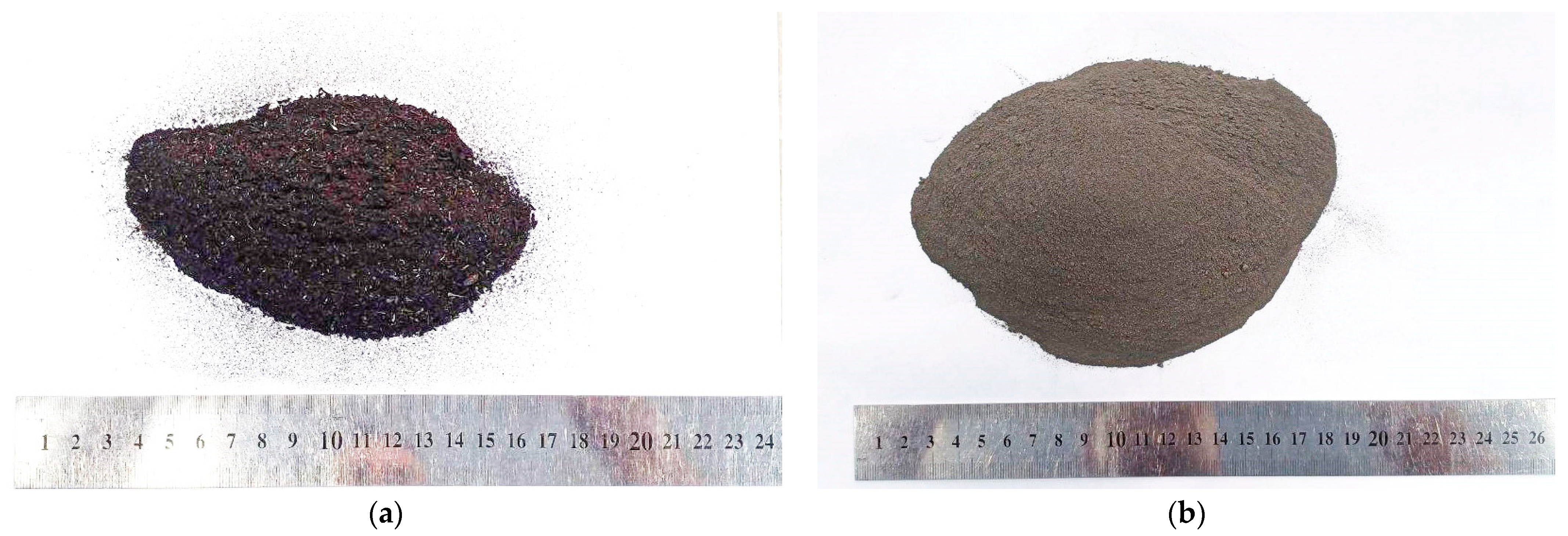
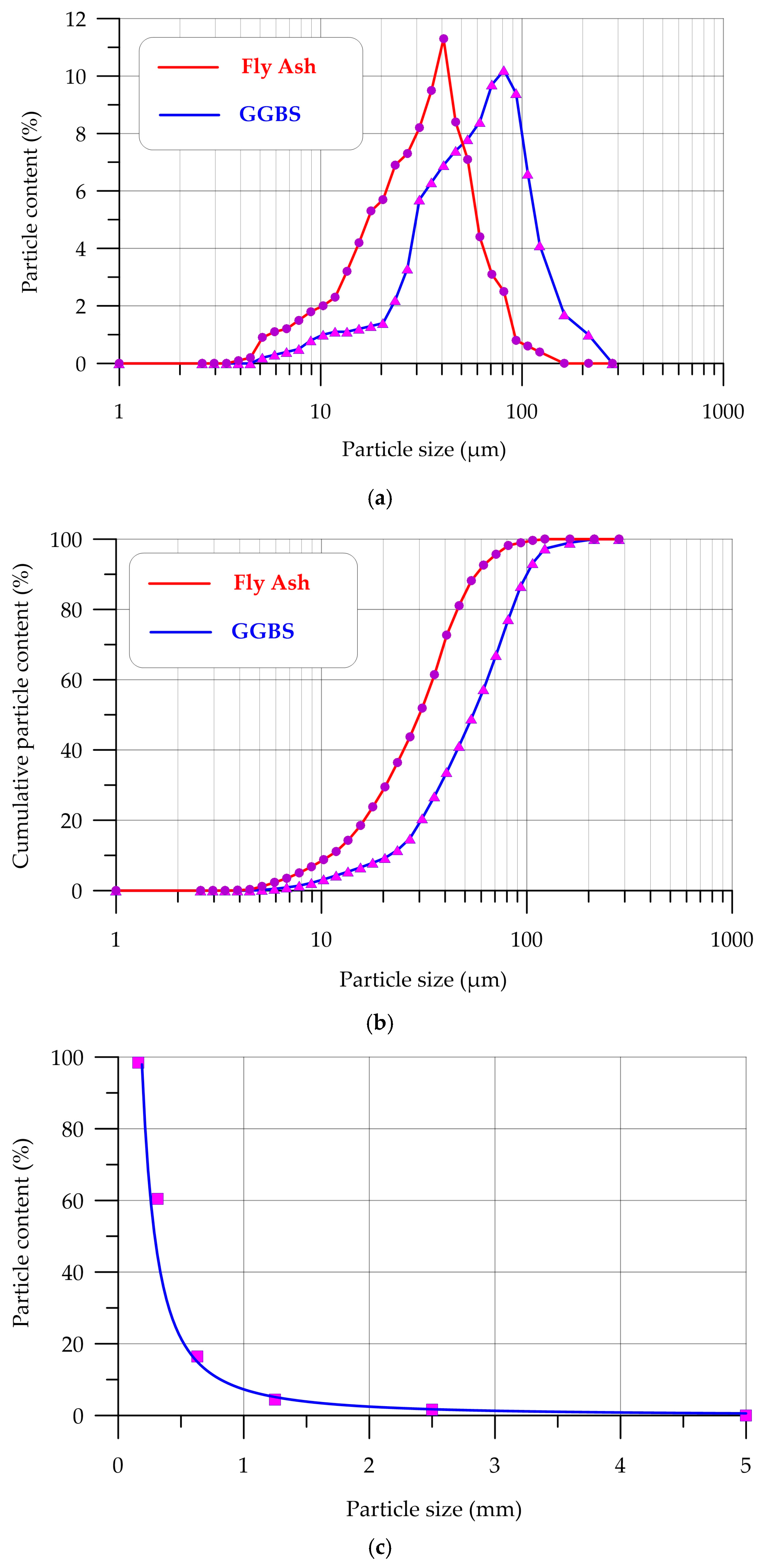


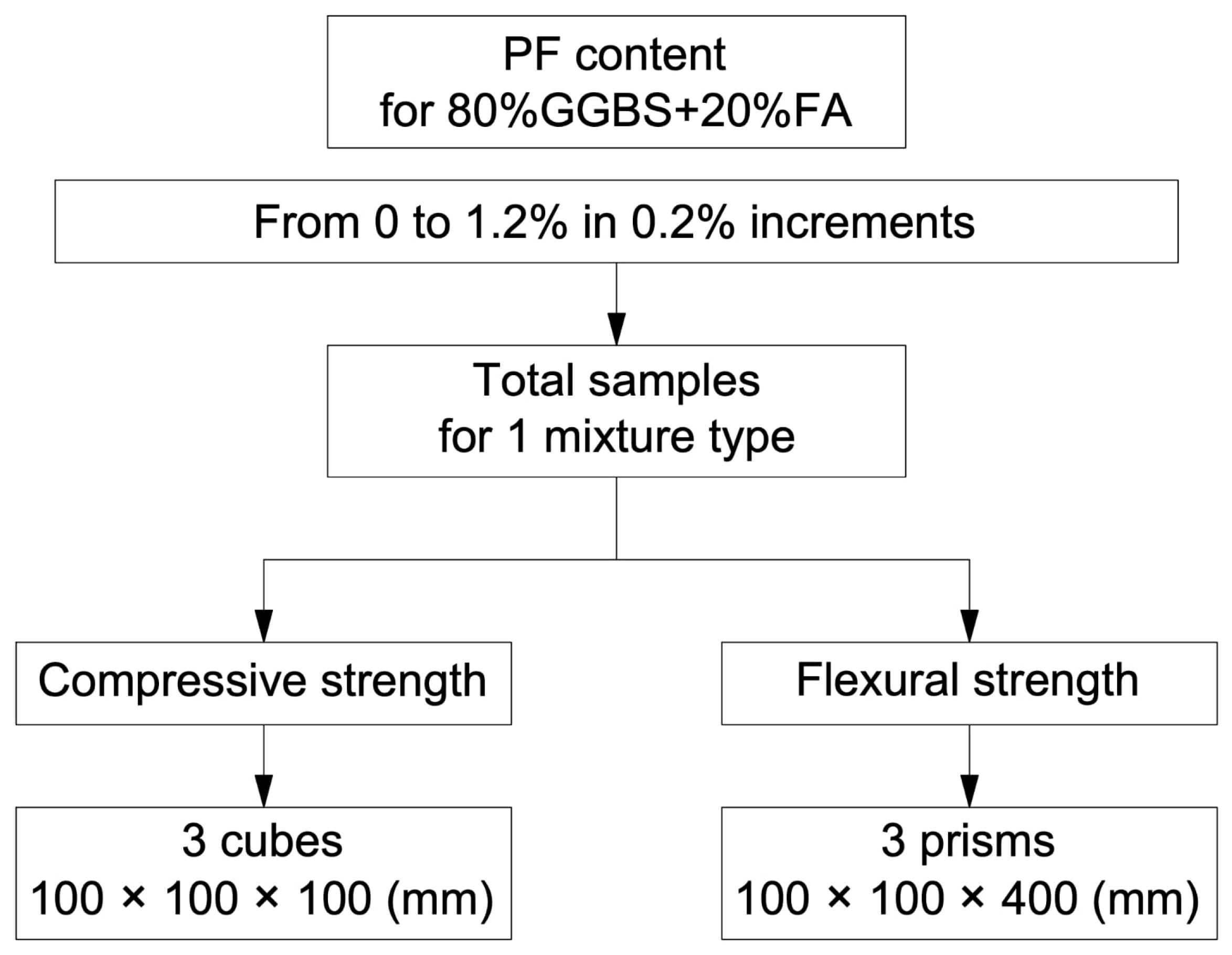

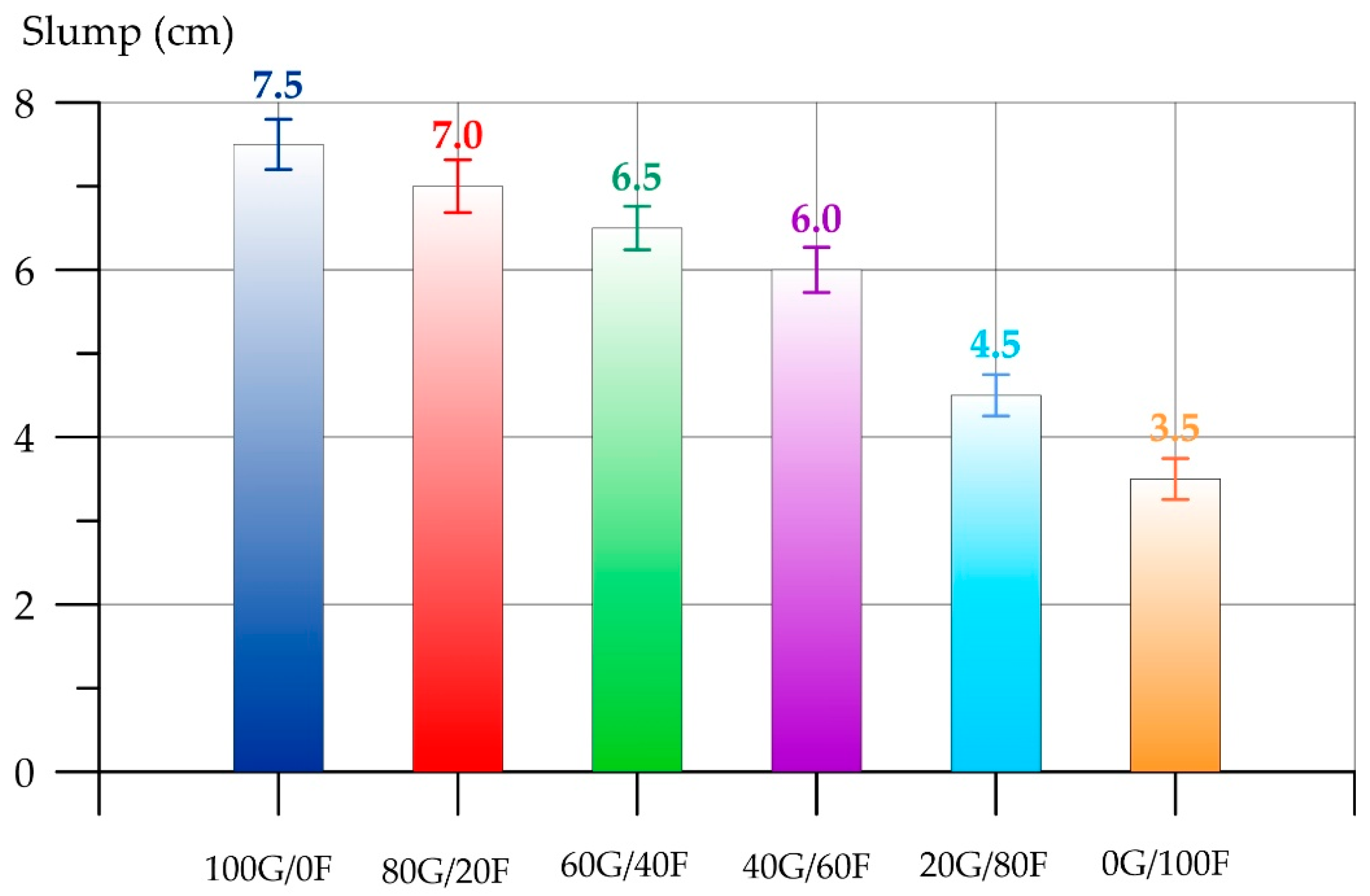
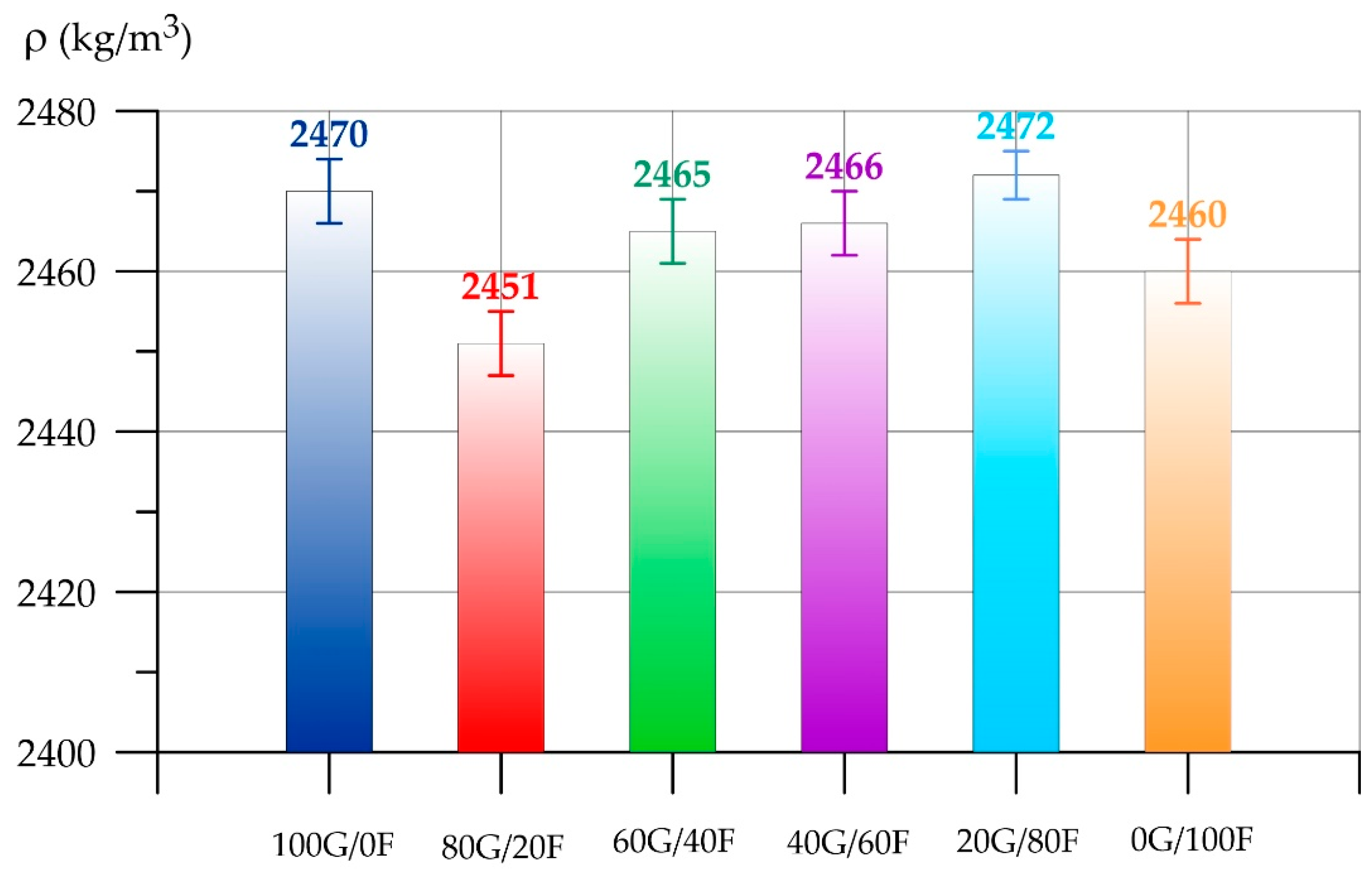

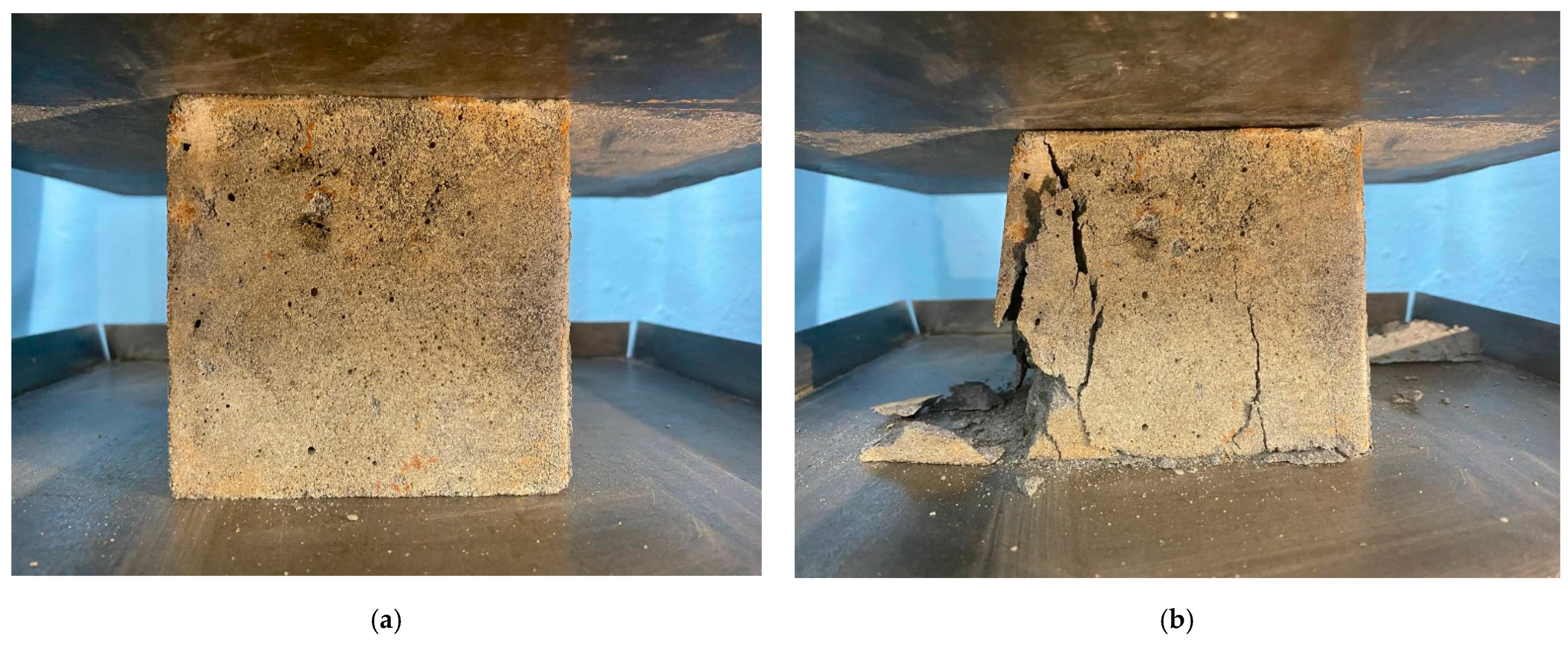
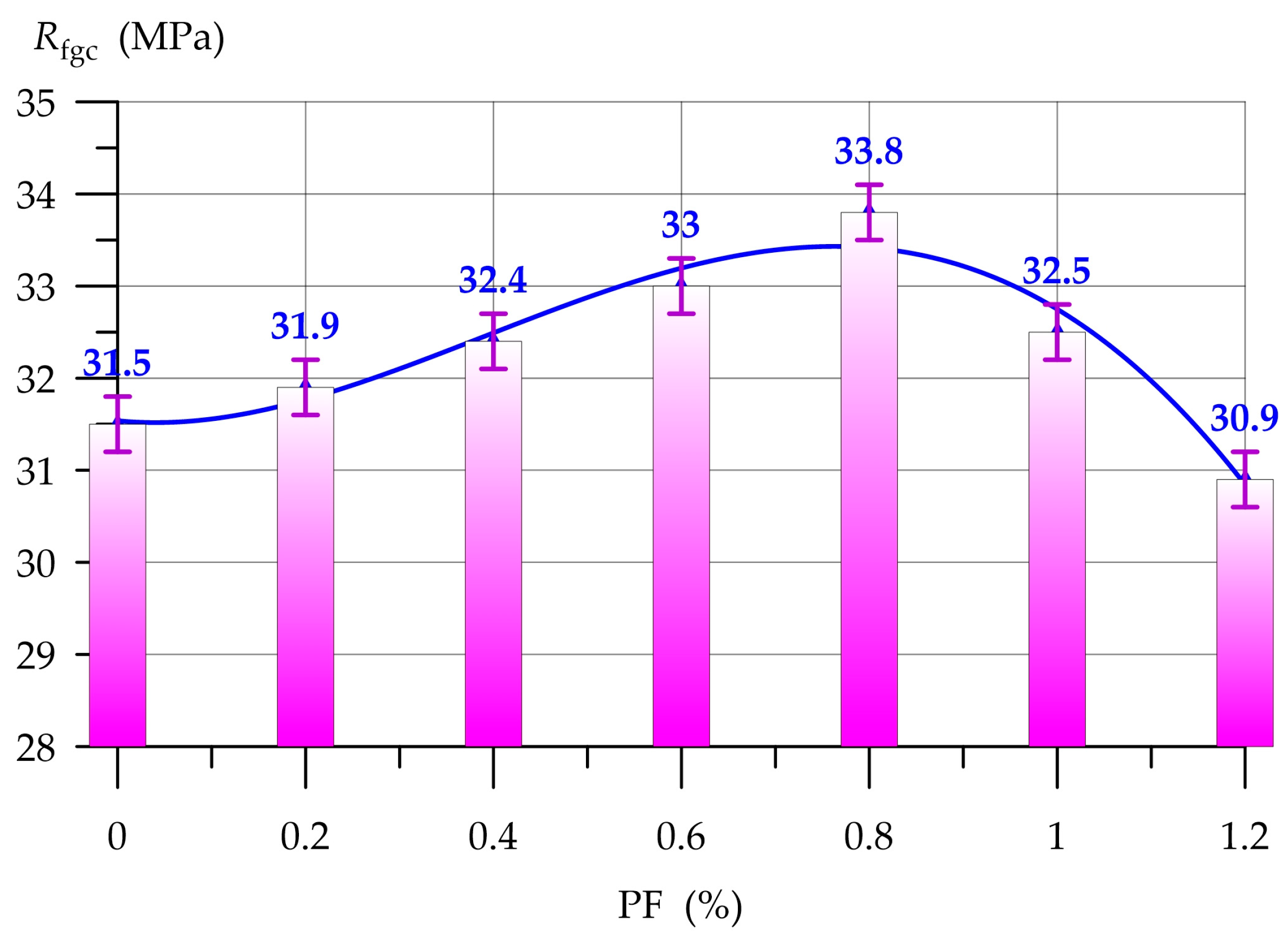

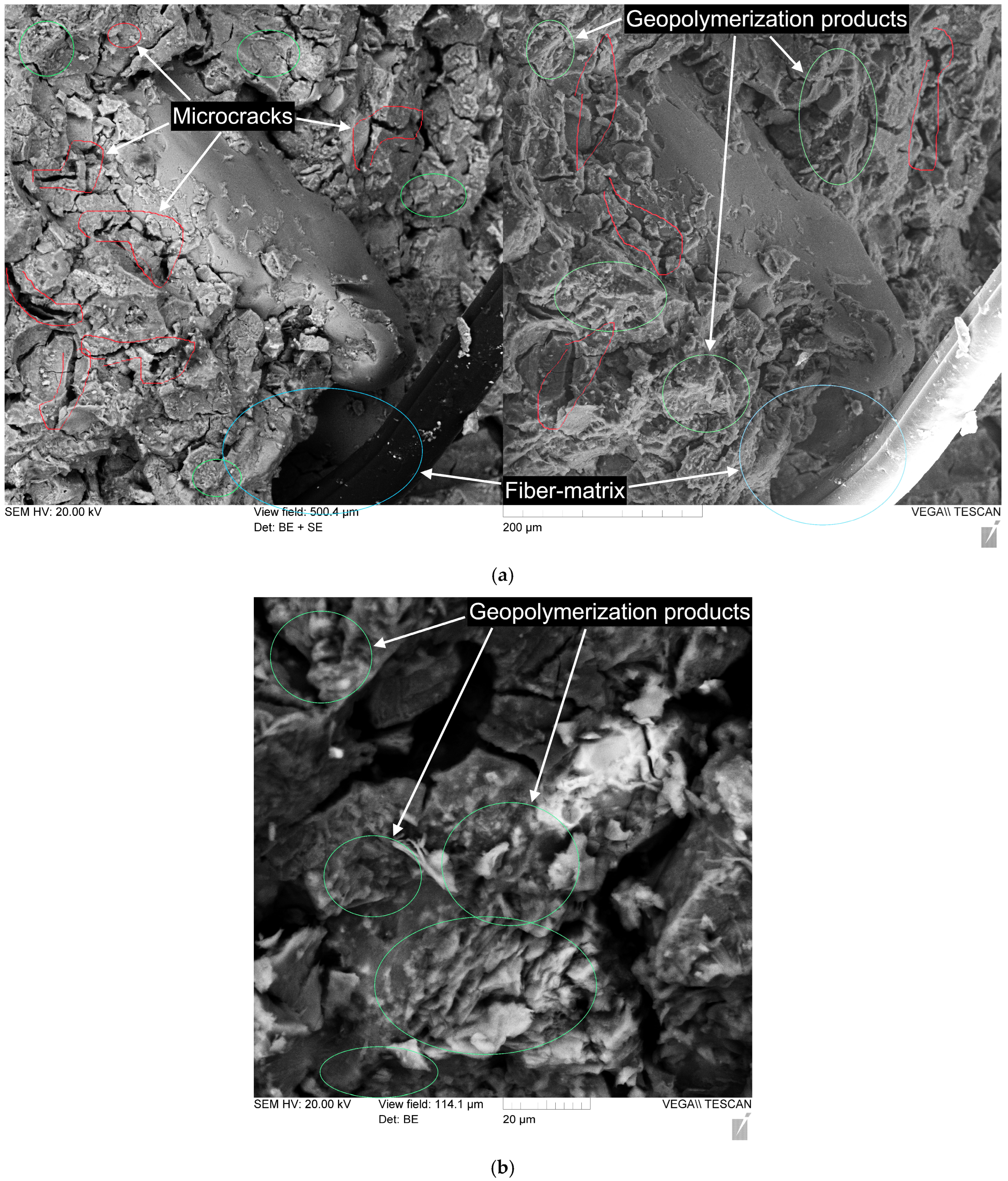


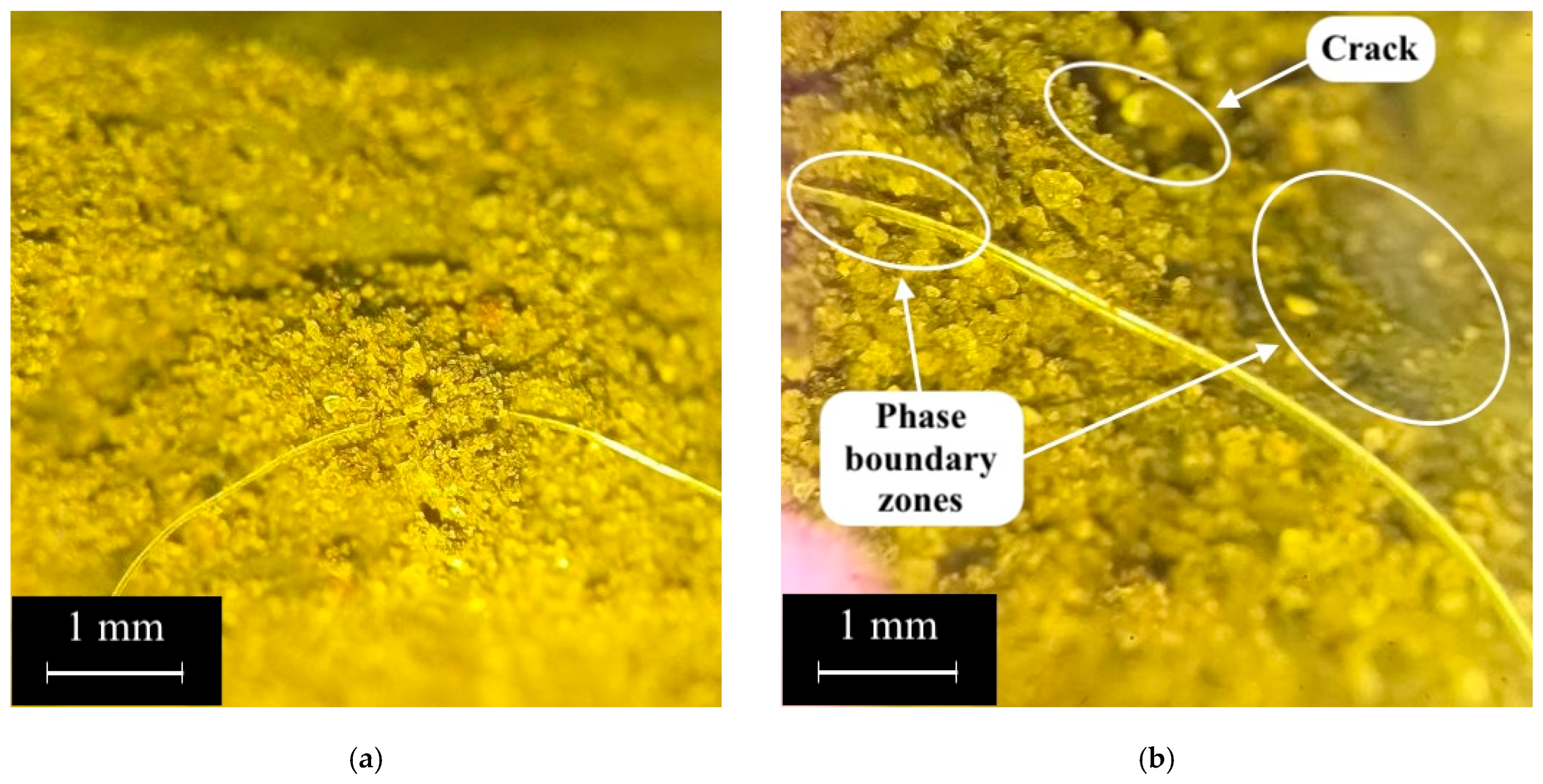
| Oxid | GGBS | FA |
|---|---|---|
| SiO2 (%) | 31.1 | 50.82 |
| Al2O3 (%) | 7.09 | 20.5 |
| Fe2O3 (%) | 0.51 | 7.71 |
| CaO (%) | 38.5 | 5.55 |
| MgO (%) | 4.32 | 2.18 |
| TiO2 (%) | 0.28 | 0.87 |
| Р2О5 (%) | 0.03 | 0.21 |
| SO3 (%) | 2.19 | 0.16 |
| LOI (%) | 15.98 | 12.0 |
| Bulk density (kg/m3) | 1098 | 1013 |
| Mixture Type | GGBS/FA (%) | GGBS (kg/m3) | FA (kg/m3) | QS (kg/m3) | CrS (kg/m3) | NaOH (kg/m)3 | Water (L/m3) |
|---|---|---|---|---|---|---|---|
| 100G/0F | 100/0 | 488 | 0 | 485 | 1272 | 31 | 190 |
| 80G/20F | 80/20 | 390.4 | 97.6 | 485 | 1272 | 31 | 190 |
| 60G/40F | 60/40 | 292.8 | 195.2 | 485 | 1272 | 31 | 190 |
| 40G/60F | 40/60 | 195.2 | 292.8 | 485 | 1272 | 31 | 190 |
| 20G/80F | 20/80 | 97.6 | 390.4 | 485 | 1272 | 31 | 190 |
| 0G/100F | 0/100 | 0 | 488 | 485 | 1272 | 31 | 190 |
| Mixture Type | GGBS (kg/m3) | FA (kg/m3) | QS (kg/m3) | CrS (kg/m3) | PF (kg/m)3 | NaOH (kg/m)3 | Water (L/m3) |
|---|---|---|---|---|---|---|---|
| PF/0.2 | 390.4 | 97.6 | 485 | 1272 | 0.98 | 31 | 190 |
| PF/0.4 | 390.4 | 97.6 | 485 | 1272 | 1.95 | 31 | 190 |
| PF/0.6 | 390.4 | 97.6 | 485 | 1272 | 2.93 | 31 | 190 |
| PF/0.8 | 390.4 | 97.6 | 485 | 1272 | 3.90 | 31 | 190 |
| PF/1.0 | 390.4 | 97.6 | 485 | 1272 | 4.88 | 31 | 190 |
| PF/1.2 | 390.4 | 97.6 | 485 | 1272 | 5.86 | 31 | 190 |
| Name of the Indicator | Calculation Formula |
|---|---|
| Cone slump | Difference between the height of the mold and the height of the highest point of the settled geopolymer mixture. Average value based on the results of two tests. |
| Mixture density | (1) here m is the mass of the measuring vessel with concrete mixture (g); m1 is the mass of the measuring vessel without mixture (g); V is the capacity of the measuring vessel (cm3). |
| Concrete density | (2) here m is the mass of the sample (g); V is the volume (cm3) |
| Compressive strength | (3) here F is the breaking load (N); A is the area of the working cross-section of the sample (mm2); α is the coefficient considering the dimensions of the samples (for samples with a side of 100 mm α = 0.95). |
| Bending strength | (4) here F is the breaking load (N); a, b, l are the width, height of the prism cross-section and the distance between the supports, respectively, when testing samples for tensile strength under bending (mm); δ is the coefficient considering the dimensions of the samples (for samples with a side of 100 mm δ = 0.92). |
| Ref Number | Type of Aluminosilicate Component | Proportion | The Obtained Result |
|---|---|---|---|
| [71] | Slag/microsilica/metakaolin | 70%/20%/10% | Repair geopolymer composition with good adhesive properties |
| [72] | Fly ash/slag | 50%/50% | Geopolymer concrete with high resistance to chloride corrosion |
| [73] | 70%/30% | ||
| [52] | Slag/fly ash/limestone | 60%/40%/+5% | Geopolymer composite with compressive strength of 42 MPa |
| [53] | Diabase sludge/slag | 30%/70% | Geopolymer composite with reduced shrinkage and compressive strength of 98.05 MPa |
| [74] | Slag/oyster shell powder | 90%/10% | Efficient and environmentally friendly composites with the required performance properties and improved durability properties |
| [75] | Slag/concrete and brick waste powder | 45%/55% |
| Ref Number | FIBER TYPE | Optimum Content | Obtained Result |
|---|---|---|---|
| [79] | Glass/Basalt | 1%/1% | Hinged geopolymer beams with the addition of glass and basalt fiber showed strength of 49% and 37% higher than that of the control geopolymer concrete |
| [80] | Polypropylene | 0.2–0.4% | Geopolymer solutions with improved strength and reduced permeability were obtained |
| [81] | Steel | 3% | Inclusion of steel fiber in geopolymer concrete after 28 days allowed to obtain a composite with a compressive strength of 107 MPa |
| [82] | 0.3% | Increase in compressive strength of permeable geopolymer composite up to 43.62% | |
| [83] | Recycled fiberglass | 2–6% | Compressive strength of foamed geopolymer composite increased by 25–165%, and shrinkage decreased by 55% |
| [84] | Mullite fiber | 10% | Increase in compressive strength up to 20% |
| [85] | Basalt | 1–2% | Geopolymer composites with improved strength and performance properties were obtained |
| [86] | |||
| [87,88,89] | Polypropylene | 0.25–2% |
Disclaimer/Publisher’s Note: The statements, opinions and data contained in all publications are solely those of the individual author(s) and contributor(s) and not of MDPI and/or the editor(s). MDPI and/or the editor(s) disclaim responsibility for any injury to people or property resulting from any ideas, methods, instructions or products referred to in the content. |
© 2025 by the authors. Licensee MDPI, Basel, Switzerland. This article is an open access article distributed under the terms and conditions of the Creative Commons Attribution (CC BY) license (https://creativecommons.org/licenses/by/4.0/).
Share and Cite
Stel’makh, S.A.; Beskopylny, A.N.; Shcherban, E.M.; Elshaeva, D.; Chernilnik, A.; Kuimov, D.; Evtushenko, A.; Oganesyan, S. Geopolymer Concrete Physical and Mechanical Properties on a Combined Binder Reinforced with Dispersed Polypropylene Fiber. Polymers 2025, 17, 1710. https://doi.org/10.3390/polym17121710
Stel’makh SA, Beskopylny AN, Shcherban EM, Elshaeva D, Chernilnik A, Kuimov D, Evtushenko A, Oganesyan S. Geopolymer Concrete Physical and Mechanical Properties on a Combined Binder Reinforced with Dispersed Polypropylene Fiber. Polymers. 2025; 17(12):1710. https://doi.org/10.3390/polym17121710
Chicago/Turabian StyleStel’makh, Sergei A., Alexey N. Beskopylny, Evgenii M. Shcherban, Diana Elshaeva, Andrei Chernilnik, Denis Kuimov, Alexandr Evtushenko, and Samson Oganesyan. 2025. "Geopolymer Concrete Physical and Mechanical Properties on a Combined Binder Reinforced with Dispersed Polypropylene Fiber" Polymers 17, no. 12: 1710. https://doi.org/10.3390/polym17121710
APA StyleStel’makh, S. A., Beskopylny, A. N., Shcherban, E. M., Elshaeva, D., Chernilnik, A., Kuimov, D., Evtushenko, A., & Oganesyan, S. (2025). Geopolymer Concrete Physical and Mechanical Properties on a Combined Binder Reinforced with Dispersed Polypropylene Fiber. Polymers, 17(12), 1710. https://doi.org/10.3390/polym17121710












